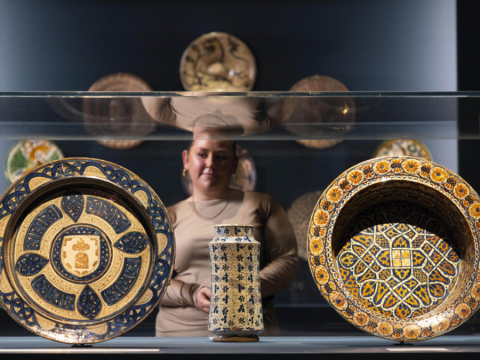
The story behind John Singer Sargent RA's 'Carnation, Lily, Lily, Rose'
By Harriet Baker
Published on 13 February 2015
With an exhibition of paintings by John Singer Sargent at the National Portrait Gallery, we take a look at one of this Royal Academician’s most famous works.
In 1884, a scandal forced the painter John Singer Sargent to leave Paris, but a painting exhibited at the Royal Academy three years later helped to revive his career.
Sargent’s portrait of Amélie Gautreau, the famous Madame X, was first exhibited in the Paris Salon of 1884 and was met with outrage, permanently damaging his reputation as an artist. He had painted his subject with wantonly exposed shoulders and deathly pale skin, much to the disapproval of the critics. Seeking restoration, Sargent moved to England and spent summer seasons in an artist’s colony in Broadway, Worcestershire. It was here that Carnation, Lily, Lily, Rose was completed.
Sargent’s first inspiration for the painting came from an evening boating trip along the Thames at Pangbourne in 1885, when he saw Chinese lanterns hanging in the trees. He began Carnation, Lily, Lily, Rose while staying at the home of the artist Francis David Millet, although the models for the two little girls, Polly and her sister Dorothy, were actually the daughters of the artist Frederick Barnard.
In this painting, Sargent reveals his cosmopolitan influences, giving in to English pre-Raphaelite impulses while holding on to the Impressionist en plein air technique he learned from his friend Monet in Paris. He painted entirely outside during the late summers of 1885 and 1886, catching the delicate twilight glow before the light faded into evening.

As the curator of the exhibition, Richard Ormond, explains: “Carnation, Lily, Lily, Rose was painted entirely out of doors at this magical twilight time of day and it’s wonderfully complicated. It’s a kind of Garden of Eden, an invented garden dense with flowers and foliage. It combines the en plein air technique with pre-Raphaelite and Aesthetic impulses. With the two little girls lighting the lanterns, it’s an image of childhood innocence.”
Carnation, Lily, Lily, Rose was first exhibited in the Royal Academy's Summer Exhibition of 1887, to a fiercely divided critical reception. A review of the exhibition in The Art Journal notes that "Mr. Sargent is certainly the most discussed artist of the year... as artists almost come to blows over this picture." The Pall Mall Gazette (a paper widely read by the middle classes) featured Carnation, Lily, Lily, Rose in the category “Pictures You Would Least Like to Live With”, as voted by the readers. However, in a write-up of the show in the Magazine of Art, the painting was praised as an "extremely original and daring essay in decoration."
Sargent was once again on everybody's lips and his reputation restored. That same year, Carnation, Lily, Lily, Rose was bought by the Royal Academy for the British public through the Chantrey Bequest, a special trust fund received by the RA in the will of Sir Francis Chantrey in 1875. Royal Academy President, Lord Leighton, supported the acquisition, along with other Royal Academicians including Sir Lawrence Alma-Tadema and William Quiller Orchardson.
Originally housed at the South Kensington Gallery (now the V&A), it was permanently placed in the newly created National Gallery for British Art, now called Tate Britain, where it is now one of the gallery's most loved paintings.

Find out more about John Singer Sargent’s diploma work, An interior in Venice, accepted by the RA in 1900 on his election.
Related articles

The great art quiz of 2024
18 December 2024

The great art quiz of 2023
20 December 2023

Introducing our 2024 exhibitions
18 May 2023

Start here: Souls Grown Deep like the Rivers
17 February 2023

